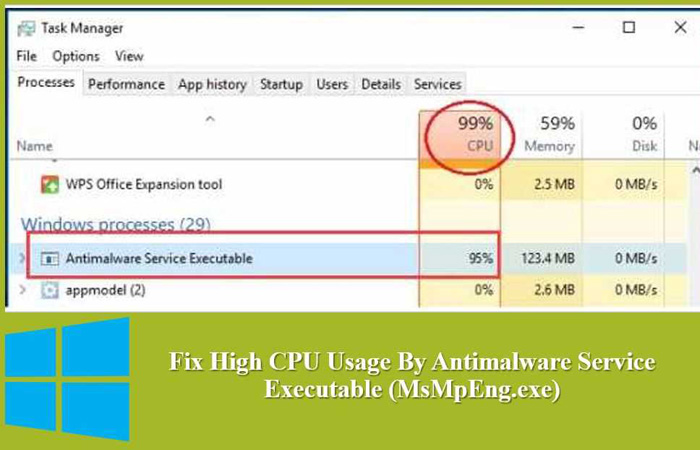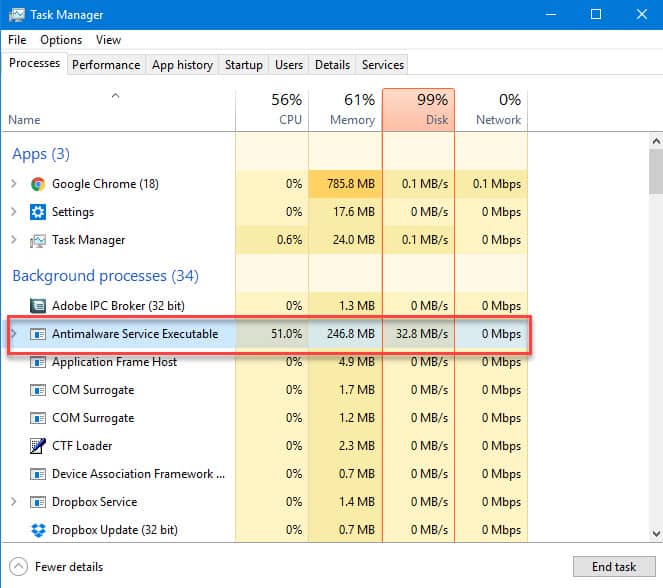Table of Contents
Over the past few weeks, some of our users have reported to us that they are experiencing high CPU usage due to the windows 8 Antimalware Service.
PC running slow?
The Antimalware Service executable (MsMpEng.exe) is literally a process that often leads to increased CPU usage in Windows. An alternative name is the Windows Defender Service, which is usually responsible for analyzing the correctness of the system in real time. Such a task results in a great ability to remember usage, which results in slowdowns or delays in the software.
How do I fix antimalware service high CPU usage?
Repair corrupted Defender files.Really reprogram Windows Defender.Disable Windows Defender.Add the antimalware service executable to the Windows Defender exclusions list.Check for malware.
The Antimalware Service Executable process plays an important role in Windows Defender. This service comes bundled with Windows 10 (and despite the similarity in name, it is completely independent of Emsisoft Anti-Malware!). However, it is also known to consume most of the processing power of the processor and can even slow down your computer speed to zero.
Why does antimalware Service eat so much CPU?
The anti-malware service executable is run to scan for all malware and spyware when it is accessed. It also requires background scanning of your software for viruses or worms. Scanning is highly dependent on your PC’s processor, so you will find that it is consuming the CPU of your main Windows 10.
If you’re a Windows Defender user and you notice high CPU usage for a very long period of time, you’ll be pleased to know that this problem can be fixed.
PC running slow?
ASR Pro is the ultimate solution for your PC repair needs! Not only does it swiftly and safely diagnose and repair various Windows issues, but it also increases system performance, optimizes memory, improves security and fine tunes your PC for maximum reliability. So why wait? Get started today!

In this article, we’ve summarized a few simple steps you can follow to prevent the Antimalware Service executable from overloading system resources and keep your system running smoothly.
What Is The Anti-malware Service Executable Msmpeng.exe?
How do I stop antimalware service executable from using so much CPU?
How can I get rid of the habit of running anti-malware services using large amounts of memory, CPU, and disk? Go to Settings> Update & Security> Virus & Threat Protection> Virus & Threat Protection Settings and remove real-time protection. It will automatically install it if it doesn’t find the antivirus software installed on your PC.
You are using Windows Defender soWhy not protect your computer? If this is the case, open the specific Windows Task Manager (Ctrl+Shift+Esc Start or Menu > Task Manager), scroll down the list of background files and you will find the anti-malware service executable file detected by the process and the corresponding file Content msmpeng.exe .
This process allows Windows Defender to regularly monitor your PC for potential threats and also provides real-time protection against malware and then cyberattacks. At the same time, this can also be the cause of disproportionately high CPU usage.

Another feature of Windows Defender that can slow down the program on several levels is Full Scan, which performs a full scan of all files on your company’s computer. A full scan is highly dependent on the main processor and is not afraid to use all available resources of your system; the fact that running it again can cause delays, slowdowns, freezes and other system failures.
How to fix antimalware service executable high disk usage on Windows 10?
Open Task Manager to check if Windows 10 has a blank executable disk and antimalware processor. You can also exclude MsMpEng.exe from Windows Defender Virus and Threat scans. This way, our own anti-malware service executable won’t run too often and consume your CPU and disk resources in Windows 7, 9, 10.
Although anti-virus programs usually useuse system resources when monitoring Windows scans, Defender requires a lot more effort than most others. The CPU has been known to be overloaded for a long period of time and scans are performed when you wake up the computer for the second time to quickly send an email or browse a website.

While this can be frustrating, it is important that users do not disable Windows Defender without first installing another computer security solution. boys! Let Do schedule your work, eliminate any threats, and then follow these steps to prevent the problem from reoccurring:
Fix #1: Change Windows Defender Accounting Options
Most users typically experience high memory consumption by the anti-malware service executable when Windows Defender is running. We can fix this schedule by running the scan at a specific time when you are less likely to use your CPU.
- Open the launch calendar, vvGo to “Task Scheduler” and click on the top result to run the program.
- Double-click Task Scheduler Library on the left side of each navigation pane. Expand these versions and navigate to the following destination: Defender-Library/microsoft/windows/windows.
- With the Windows Defender folder open, double-click Windows Defender Scheduled Scan in the center pane.
- Click the Disable Conditions tab, All Options, and click OK. This will delete scheduled scans.
- It is important that a computer with a protective mask rescan, but we can do this in a way that limits the performance impact on your system. To do this, double-click Windows Defender Scheduled Scan, select the Trigger tab, and navigate to New.
- Create a new scan schedule that suits your needs and select options to achieve a certain balance between system protection and system efficiency. As a guide, we recommend (at least) weekly checksat a time when you are unlikely to notice increased CPU usage.
- Repeat the process for the remaining three Defender responses (Windows Cache Maintenance, Windows Defender Cleanup, Windows Defender Scan) located in Library/Microsoft/Windows/Windows Defender.
Fix #2: Add The Antimalware Service Executable To The Windows Defender Exclusion List
During a scan, Windows Defender scans every file on your computer, including itself. This can sometimes lead to some interesting interactions and is a common cause of system crashes. To avoid this, simply tell Windows Defender to skip the system scan.
- Press Ctrl + Shift + Esc to open the Windows Task Manager.
- Look for multiple anti-malware services running in the process list. Right-click the main process and select Open File Location.
- In each of our address bars, you will see the full anti-malware service executable. Click on the address bar and copy the shown path.
- Open the start menu, type “defender” “windows” to click the top result and launch the specific Windows Defender Security Center.
- Click Virus & threat protection, then click Virus & threat protection settings.
- Scroll down to Exceptions, click , add or remove exceptions. On the next screen, click Add Exception, Folder, and paste the path to the Anti-Malware Service executable (MsMpEng.exe) in the address bar. Finally, click “Open” and the folder will be excluded from scanning immediately.
Fix #3: Disable Windows Defender
Should I turn off antimalware service executable?
If the antimalware plan’s executable process doesn’t get complicated every time, it can be wasted. However, if you’re having trouble consistently using resources, someone might want to disable this feature. Quite normal But disable experience and even Microsoft Defender.
If the issue persists after the first two fixes, you might be tempted to disable Windows Defender entirely. Keep in mind that by taking appropriate measures, you are vulnerable to a number of cyberattacks. Therefore, before uninstalling Windows Defender, it is important to download an effective anti-malware tool to your device.
- Press the Windows key + R to open the Run dialog.
- In the Run dialog, type regedit and click OKto open the registry editor.
- In the navigation pane on the left, double-click Folders to navigate to HKEY_LOCAL_MACHINESOFTWAREPoliciesMicrosoftWindows Defender.
- If you find a registry entry that is usually named DisableAntiSpyware, double-click it and set its value to 1. Improve the speed of your computer today by downloading this software - it will fix your PC problems.
How do I disable antimalware service executable high CPU usage?
Enter task scheduler in the search button . To expand, click Task Scheduler Library > Microsoft > Windows.On Windows, click Windows Defender.Disable “Run with highest privileges”.Uncheck all products in the “Terms and Conditions” section.
How do I fix antimalware service high CPU usage?
Repair corrupted Defender files.Reassign Windows Defender correctly.Disable Windows Defender.Add the antimalware service executable to the Windows Defender exclusion list.Scan for malware.
How do I stop Windows Defender from using so much CPU?
You can configure the MsMpEng.exe file to use a specific processor with the system to avoid crowding out a large number of processors. However, this slows down Windows Defender scanning and slows it down more than usual. If slow scanning speed is still better for you than high CPU usage.
How do I reduce antimalware service executable memory usage?
Disable real-time protection.Disable scheduled tasks.Install another antivirus program.Permanently disable Windows Defender in Windows 10.
Why is antimalware service executable running so much?
Why is it using so much CPU? If you see the Antimalware Service executable process using a lot of CPU or disk resources, it may be imitating your computer for malware. Like other IT tools, Microsoft Defender periodically visits files on your computer in the background.
Passaggi Per Correggere L’utilizzo Elevato Della CPU Eseguibile Del Servizio Antimalware Di Windows 8
Kroki, Jak Naprawić Wysokie Użycie Procesora Przez Usługę Ochrony Przed Złośliwym Oprogramowaniem W Systemie Windows 6
Как исправить высокую загрузку ЦП исполняемым файлом службы защиты от вредоносных программ Windows 8
Stappen Voor Het Repareren Van Windows 8 Antimalware-service Uitvoerbaar Hoog CPU-gebruik
Schritte Zur Behebung Der Ausführbaren Hohen CPU-Auslastung Des Windows 8-Antimalware-Dienstes
Etapas Para Corrigir O Alto Uso De CPU Executável Do Serviço Antimalware Do Windows 8
Windows 8 맬웨어 방지 서비스 실행 가능한 높은 CPU 사용량을 수정하는 단계
Steg För Att Fixa Windows 8 Antimalware Service Exekverbar Hög CPU-användning
Pasos Para Corregir El Importante Uso De CPU Ejecutable Del Servicio Antimalware De Windows
Étapes Pour Corriger L’utilisation élevée Du Processeur De L’exécutable Du Service Antimalware De Windows 8